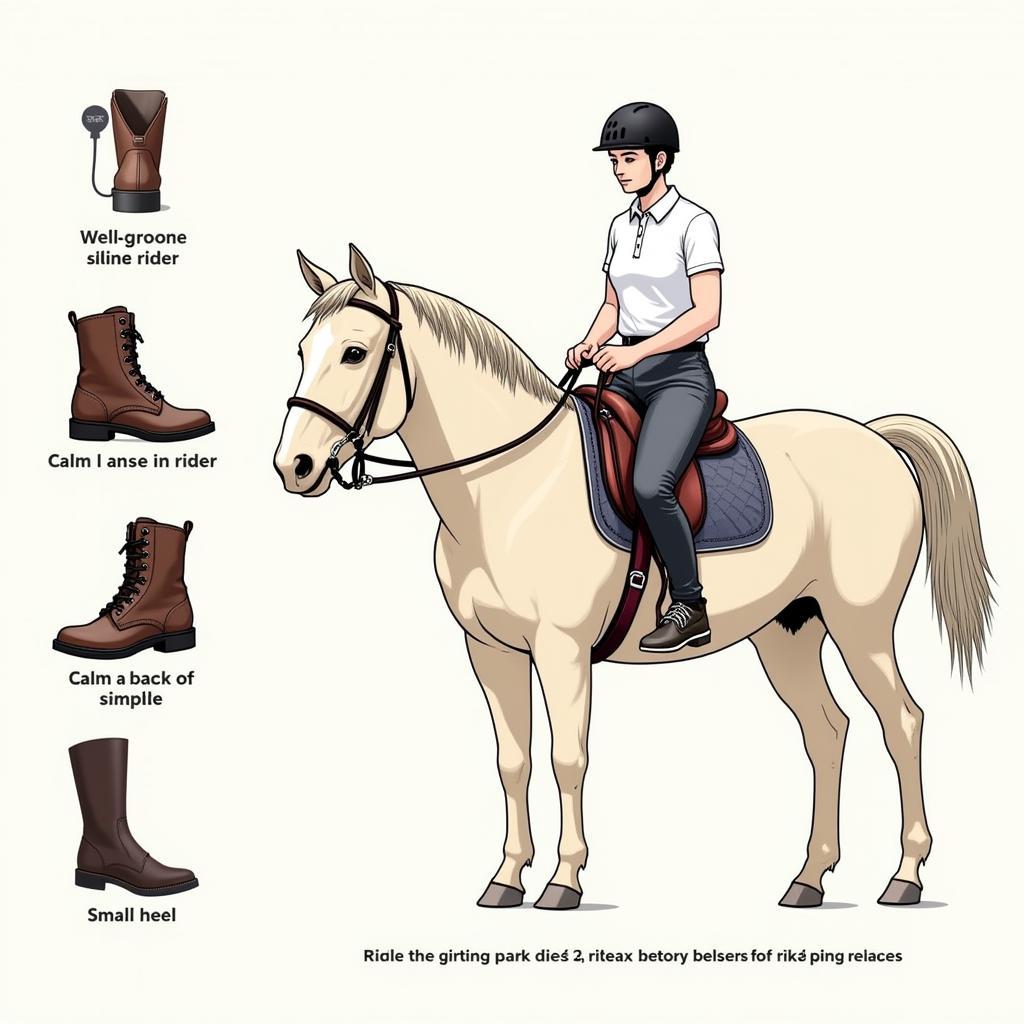Riding a horse bareback—skin against the warm coat of a horse, feeling every muscle move beneath you—is an experience unlike any other. It’s a thrilling connection with nature and a test of balance and skill. If you’re intrigued by the idea of bareback riding, this guide will cover everything you need to know to do it safely and enjoyably. Let’s delve into the world of bareback horse riding.
Preparing for Your Bareback Adventure
Before you hop on, there are several essential preparations to ensure a safe and enjoyable ride. Choosing the right horse is crucial. A calm, well-trained horse with a smooth gait is ideal for beginners. Familiarize yourself with the horse’s personality and get comfortable around them before attempting to ride bareback. A horse accustomed to bareback riders is less likely to be startled by the different feel. Proper grooming is also essential for both your comfort and the horse’s well-being. A clean, well-brushed coat will provide better grip and prevent chafing.
Next, consider your attire. While specialized bareback pads are available, many riders prefer the direct contact of skin against horsehair. Comfortable, close-fitting clothing is recommended to avoid chafing and ensure a secure seat. Avoid loose clothing that could get tangled or distract the horse. Footwear is equally important. Choose boots or sturdy shoes with a small heel to prevent your foot from sliding through the stirrup (if using safety stirrups). A helmet is always recommended for safety, regardless of your experience level.
 Bareback Riding Preparation Essentials
Bareback Riding Preparation Essentials
Mastering the Bareback Riding Techniques
Mounting a horse bareback can be a bit trickier than with a saddle. Find a slightly elevated surface, like a mounting block or a sturdy fence, to make it easier. If no such surface is available, ask someone to assist you. Once mounted, focus on finding your balance. Sit centrally on the horse’s back, with your weight evenly distributed. Your legs should hang naturally, providing gentle pressure against the horse’s sides.
Maintaining balance while riding bareback requires a combination of core strength, leg grip, and a relaxed posture. Keep your back straight, but not stiff. Engage your core muscles to help maintain stability. Your legs will play a vital role in communication and control, replacing the cues normally given by the rider’s seat in a saddle. Gentle squeezing with your legs will encourage the horse to move forward. To turn, apply pressure with the inside leg and a slight rein aid. Remember, clear and consistent communication is key.
 Bareback Riding Techniques: Balance and Control
Bareback Riding Techniques: Balance and Control
Is Bareback Riding Safe?
While bareback riding can be incredibly rewarding, it’s important to acknowledge the inherent risks. Falling is always a possibility, and without the protection of a saddle, injuries can be more severe. That’s why starting with a calm, reliable horse and gradually increasing the difficulty level is crucial. Consider using safety stirrups designed for bareback riding, which can provide additional security. Never ride bareback on a horse you’re not familiar with, especially a spirited or unpredictable one.
If you’re new to horse bareback riding, practicing in an enclosed arena or paddock is recommended. This provides a safe environment to develop your balance and coordination without the distractions of an open trail. Building a strong foundation of basic riding skills before attempting more challenging maneuvers is essential.
Enhancing Your Bareback Riding Experience
Once you’ve mastered the basics, you can explore different bareback riding activities. Try games like those you might find at horse camp games, adapted for bareback riding. This is a fun way to improve your balance and coordination. If you’re interested in trying different saddles later, you might want to look at the best horse saddle pads or even a leather horse saddle. For a different experience entirely, consider bareback submission horse.
Expert Insight: “Bareback riding allows a unique connection with your horse,” says renowned equestrian trainer, Sarah Miller. “You develop a deeper understanding of their movements and build a stronger bond through the direct contact.”
Another expert, John Davis, adds, “It’s an incredible feeling of freedom. There’s nothing quite like the sensation of moving as one with your horse.”
Conclusion
Riding a horse bareback is an exhilarating experience that offers a unique connection with these magnificent animals. By taking the necessary precautions and practicing regularly, you can safely enjoy the thrill and freedom of bareback riding. Remember to always prioritize safety, choose a suitable horse, and build your skills gradually. So, embrace the adventure, feel the wind in your hair, and experience the pure joy of riding a horse bareback!
FAQ
- What is the best type of horse for bareback riding? Calm, well-trained horses with smooth gaits are ideal.
- Do I need special equipment for bareback riding? While not required, bareback pads and safety stirrups can enhance safety and comfort.
- Is bareback riding more difficult than riding with a saddle? It can be, especially at first, as it requires greater balance and coordination.
- What should I wear for bareback riding? Close-fitting, comfortable clothing and sturdy footwear with a small heel.
- Where is the safest place to practice bareback riding? An enclosed arena or paddock is recommended, especially for beginners.
- How can I improve my balance for bareback riding? Practice regularly, engage your core muscles, and focus on a relaxed posture.
- Is bareback riding safe for children? Yes, with proper supervision, a suitable horse, and safety precautions.
Need assistance? Contact us 24/7: Phone: 0772127271, Email: [email protected] or visit us at QGM2+WX2, Vị Trung, Vị Thuỷ, Hậu Giang, Việt Nam.